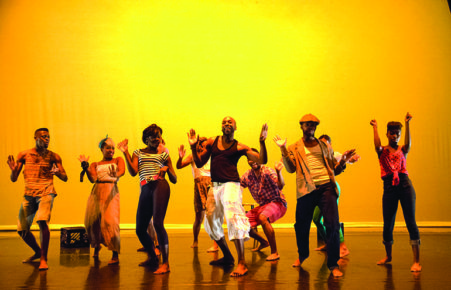“The essence of the play is joy. If you could bottle it and sell it, you’d be rich,” says dancer Hollywood Jade of the Gimme One Riddim dance theatre production.
The celebrated showcase includes a talented cast of highly dedicated artists who dance with a fire-burning passion, even while practicing. As the female dancers take control of the relatively small rehearsal space at the Studio 313 & 314 in Toronto’s Distillery District, the male dancers warm up with push-ups. On the count from choreographers, Natasha Powell and Jasmyn Fyffe, all the dancers come together and begin.
The dancers slide, wine and are sometimes picked up into the air. Fyffe explains the inspiration behind the dance routines. “The dancers inspire the movement we create on them because it’s not an empty canvas where you just draw. It’s like the canvas is shaped in a different way. We take inspiration from what they naturally can do and how they move and then you create movement that looks good on their body within the framework of what we want chorographically.”
Now in its third show run, Gimme One Riddim is a production that combines Caribbean, contemporary and street dance with theatre to share powerful stories through a celebration of the Jamaican musical genre, ska. Twenty-six-year-old dancer Irvin Washington explains that this year the production will contain a lot more acting and character development, where in each scene the dancers become someone. “One scene I’m playing my dad, William, whereas [the character of] Desmond has a different attitude, he’s more of a kid that’s looking for shelter and home and suffering through this poverty situation.”
The characters are used to make the scenes more authentic and less generic, says Washington, but it isn’t always easy playing particular characters. “It’s been kind of tough [preparing for the show]. I’ll speak about one piece in particular, “Africa”. I’m usually a pretty happy person and this piece requires so much more depth. You’d be surprised of how challenging it is to be down and to show struggle.” The dancer goes as far as to watch movies in order to prepare for his more dramatic roles.
It’s a huge story the dancers must tell, says fellow dancer Jade. “It’s history. It’s the evolution of the music of Jamaica.”
The dancers rehearse the scene “Life Could Be a Dream”, where all the male dancers embody characters on a boat who are leaving Jamaica for England in order to pursue their career. “There isn’t a lot of dancing in the scene. It’s really character driven. That part of the show is so simple, but so effective,” says Powell.
Jasmyn and Powell want to bring the different male energy to the stage. “Now in this generation, the male voice in dance is starting to bring itself back and redefining itself so it’s really exciting to see that happen in this show,” says Powell.
On a similar note, Jade expresses the same excitement for the new generation of male dancers. The unity of the team of dancers is sensed beyond the unison of their movements, it is heard through their laughter. “It’s very rare that you get to have the opportunity to dance with another group of black males and it be viewed as positively as this is being viewed.”
Words By. Faduma Mohamed




Comments are closed.